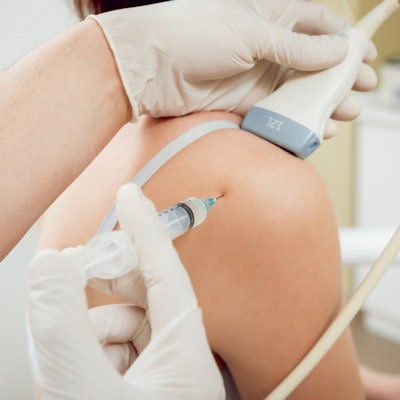
Ultrasound-guided injections are an effective way to manage chronic shoulder pain, and they are well tolerated by most patients, according to a new study presented at the recent EuroSon congress in Granada, Spain.
Shoulder pain is very common, having a prevalence of around 16% to 26% in adults, and the muscles involved comprise the supraspinatus, infraspinatus, teres minor, levator scapulae, trapezius, and rhomboid, explained Dr. Hong-Jen Chiou and colleagues from the division of ultrasound and breast imaging in the department of radiology at Taipei Veterans General Hospital in Taiwan. The pain affects the acromioclavicular joint and adhesive capsulitis, and the enthesis consists of acromioclavicular joint capsule insertion, coracoid process, and acromial process.

Myofascial pain syndrome is caused by myofascial trigger points and is a possible etiology of shoulder pain, they continued. Both infraspinatus and teres minor myofascial pain are common origins resulting in posterior shoulder pain.
"The identification of myofascial trigger points by physical palpation is unreliable and has poor interrater reliability, and therefore hinders accurate injection therapy," they noted in a poster exhibit. "Ultrasound can be used to navigate the injection needle, offer dynamic images of the immediate response to injection therapy, facilitate localization [and] injection accuracy, and reduce adverse events."
Treatment of shoulder pain of myofascial origin varies and is only moderately effective in relieving pain. Methods include trigger point injection, dry needling, steroids, lidocaine and botulinum toxin, and hyperosmolar dextrose solution injection. Local hyperosmolar dextrose may attract inflammatory mediators and release growth factors, which can then facilitate tissue remodeling and symptom relief, the authors wrote.
Patient selection
Chiou and colleagues chose to evaluate the efficacy of ultrasound-guided management for treating refractory chronic shoulder pain. Patients with chronic shoulder pain (i.e., pain periods of more than three months) referred from outpatient clinics received an ultrasound exam with compression test to make sure there were no other clinical possibilities and no contraindications to injection.
They performed 278 ultrasound-guided injections between August 2015 and December 2018. Patients returned to the outpatient clinic for follow-up one month after treatment. Their mean age was 59.1, and the age range was 44 to 85. The average visual analog score before treatment was 7, the range being between 4 and 10.
An ultrasound-guided injection of 10 mL of 15% dextrose solution (mixed 2 mL 2% lidocaine) was injected into the affected site (muscle, enthesis) for myofascial pain (perimysium dissection) or enthesitis (dry needling and injection D15W). Normal saline mixed with 1 mL of triamcinolone acetonide (Shincort) into the shoulder joint was used for cases of adhesive capsulitis. The treatment interval was one month, and the total treatment course was two injections for enthesopathy and one injection for myofascial pain.
The team evaluated the effectiveness of the treatment by obtaining visual analog scale scores for pain at the target area, before treatment and three months after treatment.
The target locations were infraspinatus muscle (100 cases), teres minor muscle (58), levator scapulae muscle (37), adhesive capsulitis (33), trapezius muscle (26), coracoid process (14), and rhomboid muscle (10).
| Results of follow-up 3 months after treatment | ||||||||
| Result | Infraspinatus | Teres minor | Levator scapulae | Coracoid | Rhomboid | Trapezius | Adhesive capsulitis | Total |
| Cure | 33 | 17 | 10 | 3 | 2 | 7 | 6 | 78 (28%) |
| > 50% improvement | 55 | 34 | 15 | 8 | 5 | 13 | 18 | 148 (53.2%) |
| < 50% improvement | 8 | 4 | 10 | 2 | 2 | 3 | 4 | 33 (11.9%) |
| No response | 4 | 3 | 2 | 1 | 1 | 3 | 5 | 19 (6.8%) |
| Total | 100 | 58 | 37 | 14 | 10 | 26 | 33 | 278 |
In follow-up three months after treatment, 78 patients (26%) were pain-free, 148 (53.2%) reported an improvement of pain of more than 50%, 33 (11.9%) reported an improvement of pain of less than 50%, and 19 (6.8%) had no response.
The mean reported post-treatment visual analog scale score was 1.83, and there were no significant immediate reactions or complications after the intervention.
Overall, ultrasound-guided injections resulted in a statistically significant improvement in the clinical symptoms of most patients, the authors concluded.



















